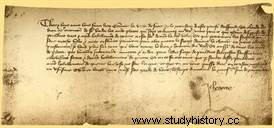Far from the great battles (often French defeats), the devastating English rides of the Black Prince, or the struggles for the big cities (Orleans, Paris,...), he is a region in France which was the unknown but decisive theater of the Hundred Years War , and the conflict between Armagnacs and Burgundians . Located on the banks of the Loire, respectively on the margins of the Duchy of Berry and the Duchy of Burgundy, Sancerrois and Nivernais have seen the greatest figures of the conflict pass and confront each other, from Charles VII to the Duke of Bedford, passing by Jean sans Peur and Joan of Arc, defeated at La Charité-sur-Loire by a curious individual, Perrinet Gressart. For about twenty years, at the beginning of the 15th century, the Loire was thus a veritable frontier of the Hundred Years War.
The county of Sancerre (14th-15th century)
Sancerrois has been part of the royal domain since the 13th century. The history of the Counts of Sancerre is directly linked to the battles of the Hundred Years War. Indeed, Count Louis II was killed at the Battle of Crécy in 1346. His son Jean III succeeded him, who was taken prisoner with the King of France Jean le Bon at the Battle of Poitiers (1356). He remains one of the king's guarantor hostages following the Treaty of Brétigny (1360).
Meanwhile, the Englishman Robert Knolles is ravaging the Loire Valley as far as Cours-les-Barres, about fifty kilometers south of Sancerre. Taking advantage of the instability of the region, armed bands plundered the monastery of Saint-Satur, very close to Sancerre, in 1361. Three years later, Great Companies led by the Englishman John Aymery occupied La Charité-sur-Loire and in turn try a hand against Sancerre. Count Jean III, returned from captivity, pushes them back. It was probably at the time of Jean III that the Tour des Fiefs (still visible today) was built in Sancerre.
The Count had only two daughters, and the eldest, Marguerite, succeeded him as Countess of Sancerre on his death in 1402. By marriage to Béraud II, dolphin of Auvergne, Marguerite transmits the county to the house of Auvergne. The first count of Sancerre of this new house is Béraud III, from 1419. It is the moment of the beginning of the civil war Armagnacs against Burgundians, and the Sancerrois finds himself logically in the first camp.
The County of Nevers (14th-15th century)
The history of Nivernais is a bit more complex. In the 14th century, the county of Nevers was under the domination of the counts of Flanders, a region at this decisive period in the rivalry between France and England. Count Louis II of Nevers (Louis I of Flanders) was killed in Crécy in 1346, like the Count of Sancerre (and many others). His son Louis III, who succeeded him, then paid homage to the King of France, Philippe VI de Valois. In 1347, apparently on the king's advice, Louis III married Marguerite de Brabant. The King of England, Edward III, resented him for having chosen allegiance to the King of France, and if Louis III was not present in Poitiers, he had to endure the English cavalcades of the late 1350s, with notably the siege by the English of Nevers and Auxerre. In 1369, he married his daughter Marguerite to the Duke of Burgundy, Philippe le Hardi, who helped him drive the English out of Nivernais in the early 1370s.
This decision is fundamental for the County of Nevers, which at the end of the 14th century passed under the domination of the Duchy of Burgundy. Philippe le Bold's son, Jean, was Count of Nevers at the age of thirteen, in 1384. Twelve years later, the young count participated in a crusade against the Turks, destroyed at Nicopolis, where he captured. Yet it was during this expedition that he was nicknamed "Jean sans Peur".  ...On his return to Nivernais, the Count fortified Nevers; the Porte du Croux dates from this period. In 1404, Jean succeeded his father as Duke of Burgundy. The county of Nevers fell to his brother Philippe, who took part in the fighting in the north of France alongside Jean, when the civil war between Armagnacs and Burgundians broke out.
...On his return to Nivernais, the Count fortified Nevers; the Porte du Croux dates from this period. In 1404, Jean succeeded his father as Duke of Burgundy. The county of Nevers fell to his brother Philippe, who took part in the fighting in the north of France alongside Jean, when the civil war between Armagnacs and Burgundians broke out.
But in 1415, Philippe de Nevers was killed at the Battle of Agincourt. His sons Charles and Jean being too young, it was their mother, Bonne d'Artois, but even more so the Duke of Burgundy, who decided the fate of Nivernais, which at that time became a decisive region for the war, even more so when the Duchy of Burgundy chose the English camp in 1419, following the assassination of Jean sans Peur. His son, Philippe le Bon, married Bonne d'Artois and obtained guardianship of his sons, and of the county.
Armagnacs, Burgundians and English for control of the Loire
From 1419 a fundamental phase of the Hundred Years War took place, which involved the conflict between the Armagnacs and the Burgundians. And the Loire alone is a decisive strategic element, especially the region from Gien to Nevers.
In previous years already, the Sancerre and Nivernaise banks of the Loire have experienced a few attacks, in particular by truckers and brigands, from one side or the other. A few anecdotes show a tension that persists and increases, and a region that bears the brunt of the disasters of war. Let us cite the example of the monks of Saint-Satur, between Sancerre and Cosne-sur-Loire, whose monastery was looted by English truckers in 1420 (after the looting of 1361). The monks are ransomed, but since no one can (or wants) to pay, most are sent to Cosne and drowned in the Loire. Only eight survived, and took refuge in Sancerre.
But the Loire quickly became the main center of attention of the Dauphin Charles, future Charles VII, then "king of Bourges", in Berry, on the Sancerre side. He insisted on taking the Anglo-Burgundian places on the right bank of the river. In 1422, he came to lay siege to Cosne, held by the Sire de Reuillon. This one ruse by promising to deliver the city if it did not receive reinforcements before mid-August. But he knows that the Duke of Burgundy and the King of England, Henry V, are on their way. The English sovereign, ill, must return to Vincennes, but Philippe le Bon approaches, accompanied by the Duke of Bedford; the Dauphin then preferred to retire to La Charité-sur-Loire, which he had recently occupied. The English counter-attack by crossing the Loire and laying siege to Sancerre, from which Charles had launched his attack on Cosne; the city is saved only by the announcement of the death of Henri V, which decides the English to turn back. The Dauphin meanwhile returned to Bourges, and a curious character, Perrinet Gressart, took the opportunity to take La Charité-sur-Loire, a strategic place because of its bridge over the Loire, the only one in the region with those further south and less protected, from Decize and Nevers.
Perrinet Gressart master of La Charité-sur-Loire
Of uncertain origin, Perrinet Gressart would have participated in Agincourt on the English side. He was above all a mercenary who made himself known in 1417 by capturing and ransoming Louis de Bourbon, 15, half-brother of Bonne d'Artois, Countess of Nevers! The Duke of Burgundy, Jean sans Peur, must intervene in person. Two years later, the mercenary looted the priory of La Charité-sur-Loire, and at the request of the clerics, he was excommunicated by the Council of Constance. This does not seem to move him and he continues his mercenary/looter activities in the region, in the service of the English and the Burgundians, but above all of himself.
Although he occupied La Charité for a while, he did not seem to be present when the city was taken by the future Charles VII in 1421. On the other hand, it was him who takes it back a year later (or in 1423), and makes it the headquarters of his raids in the region. He manages to put the population on his side, and installs other points of support, in particular in Passy-les-Tours. The fortifications of La Charité, partly destroyed under Charles V (the town had been held in the 1370s by two English captains hostile to the king), were renovated by Perrinet Gressart. 
Burgundians and English tried in vain to persuade him to deliver the city to them, whose bridge was of inestimable strategic value. The Earl of Suffolk even goes so far as to move to convince him. The mercenary is no more understanding towards the other camp:in 1425, he captures the adviser to the Dauphin, Georges de La Trémoille, who was on his way to Burgundy to negotiate! The ransom was not paid until March 1426, and Perrinet Gressart strongly threatened the negotiations between Armagnacs and Burgundians. The same year, he strengthened his position by getting his hands on La Motte-Josserand, near Cosne, a town that his men already controlled. It was not until the Treaty of Corbigny (February 26, 1427) that Perrinet Gressart agreed to hand over La Charité to the prior, and withdrew to La Motte-Josserand. But in fact, he is still the master of the region, as the following episode proves.
Jeanne d'Arc versus Perrinet Gressart
In 1427, the Duke of Bedford besieged Montargis to launch an offensive on the Loire and Berry. But on September 5, the English were pushed back by Jean d'Orléans, known as "Dunois", and "La Hire". Once king, Charles VII concentrated his armies in Gien and near Bourbonnais and Decize. The town of La Charité-sur-Loire is more than ever the center of its attention, thanks to its bridge.  On the English side, we continue to try to seduce Perrinet Gressart. Owning the city is essential for them on the road to Bourges. Thanks to the Duke of Bedford, the mercenary obtained possessions in Normandy from the young King Henry VI; he thus becomes a vassal of the King of England! This does not mean that he delivers La Charité to the English...
On the English side, we continue to try to seduce Perrinet Gressart. Owning the city is essential for them on the road to Bourges. Thanks to the Duke of Bedford, the mercenary obtained possessions in Normandy from the young King Henry VI; he thus becomes a vassal of the King of England! This does not mean that he delivers La Charité to the English...
In the camp of Charles VII, the decision to attack La Charité was partly linked to Joan of Arc's problems with the king's entourage. Indeed, after the failure before Paris in September 1429, the Maid saw her aura fade at court. The advisers, around La Trémoille, then seem to manage to get her away from Charles VII by asking her to take the city on the Loire, when she would have preferred to attack Normandy or the Île-de-France. -France. She will be accompanied by Charles d'Albret. The idea seems incongruous because the period, the winter of 1429, is not at war. Jeanne must ask for help from several cities, including Orléans and Riom, to finance her expedition.
Jeanne d'Arc takes Saint-Pierre-le-Moûtier on November 5, and Moulins-sur-Allier on November 9, 1429. Then she lays siege to La Charité-sur -Loire. The place is obviously defended by Perrinet Gressart. The details are little known, but we know that there would have been only two assaults, the besiegers being hampered by the mud, which made the use of artillery difficult. Perrinet Gressart would also have carried out a ruse to rout the foot troops of Charles d'Albret. The siege is abandoned before Christmas, and Jeanne returns to Jargeau, near Orleans. Even if all the sources do not confirm it, it would have left part of its artillery on the spot, which Perrinet Gressart does not hesitate to add to its booty. 
The news is causing a stir. Jeanne is criticized by La Trémoille and the other advisers of the king, but it is especially the count of Nevers and the duke of Burgundy who protest. Indeed, negotiations continued between Charles VII and Burgundy, and the attack on La Charité, a town normally from Nivernais and Burgundy, was very badly taken. La Trémoille must then affirm that only Perrinet Gressart was targeted.
The Treaty of Arras and peace between the kingdom of France and Burgundy
Jeanne's failure before La Charité-sur-Loire does not ultimately call into question the rapprochement between France and the Duchy of Burgundy. La Pucelle captured and then killed by the English, negotiations continued in the following years. Charles de Nevers obtained a truce between the Duke of Bourbon and the Duke of Burgundy, and the feast was celebrated in Nevers in 1435. Indeed, despite Perrinet Gressart, the Count of Nevers always knew how to maintain a certain neutrality in conflicts, whether between Charles VII and the English, or between Armagnacs and Burgundians. It was in Nevers that the foundations of the peace of Arras were laid.
The Treaty of Arras was signed on September 20, 1435, and marked the end of the civil war between Armagnacs and Burgundians. Freed from the tutelage of Philippe le Bon, the Count of Nevers, Charles, swore allegiance to the King of France and helped him get rid of the gang leaders in the Nivernais.
The most dangerous of them, Perrinet Gressart, is however not easy to dislodge. This one still holds under its thumb Cosne, Decize, and of course La Charité-sur-Loire. The Count of Nevers and Charles VII then decided to buy it rather than fight it! The mercenary thus becomes captain of La Charité, of La Tour de Cosne, and captain general of Nivernais; he receives the huge sum of 22000 gold salutes! All the same, Charles VII had to go to La Charité in person in 1440 for the city to be delivered to him...Perrinet Gressart died, very rich, in La Motte-Josserand, in 1442.
As for the counties of Nevers and Sancerre, the end of the Hundred Years War did not solve everything for them. In particular the Nivernais, still in the orbit of the Duchy of Burgundy, whose conflict with France resumed under Louis XI...
Bibliography
- B. Bove, The Time of the Hundred Years War, Belin, 2009.
- P. Contamine, O. Bouzy, X. Hélary, History and Dictionary of Joan of Arc, Robert Laffont, 2011.
- A. Faivre, Cosne through the ages, Bourra editions, 1895.
- J. Faugeras, Sancerre, two thousand years of history, Terroir, 1998.
- J. Faugeras, Perrinet Gressart, Aaz, 2005.
- A. Massé, History of Nivernais, Traboules editions, 1937.
- E. Roger, La Charité-sur-Loire, a city in History, La Charité-sur-Loire, 2006.
- Charity, place of war, Friends of Charity, 2002.
- Aspects of Nivernais in the Middle Ages:11th-15th centuries, General Council of Nièvre, 1997.
